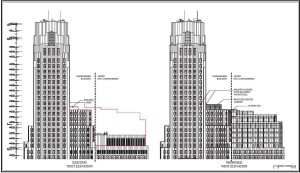
Rendering of 1 Wall Street proposal. Image credit: Macklowe Properties/Robert A.M. Stern Architects/SLCE Architects
Robert A. M. Sterne-designed project would see the addition of several stories to an un-designated annex, and the creation of two additional window bays on south facade, among other work. On January 19, 2016, the Landmarks Preservation Commission considered a proposal for alterations to the individually landmarked 1 Wall Street Building. The 1931, 50-story, Art Deco skyscraper in Lower Manhattan was built as an office tower by the Irving Trust Company to designs by architect Ralph Walker. An annex to the building was constructed in the 1960s, and is not part of the landmarked site. The current owners, Macklowe Properties, intend to convert the building to residential use, with ground-floor retail.
Architect Robert A.M. Stern, who also serves as Dean of the Yale School of Architecture, said the proposed work and subsequent adaptive reuse would bring the building “back to glory” while adding to the neighborhood’s “vitality.” Stern associate Hernan Chebar presented the proposal’s details. Terraces would be created above certain setbacks on the historic tower. An addition termed “the winter garden” would be constructed on an existing setback above the 57th floor. Chebar characterized the addition’s design as “modern but respectful,” with large windows and cat stone matching the original limestone. A connector would be created between the Annex additions and the main building. On the tower’s south facade, the number of window bays would be increased from three to five to make the apartments more desirable.
At the ground floor a canopy would be installed at the newly created main entrance on Broadway. Advertising signs and vitrines would be added for the new storefronts created for retail tenants. Internal floors would be removed to make for higher ceilings for retail spaces. The lost floors would mean the additions would not create a net gain in floor area. The project would also include a restoration component, with metalwork and windows returned to their original condition.
Multiple stories would be added to the annex of the building that is not under Landmarks’ jurisdiction.
A representative of Manhattan Community Board 1, Alice Blank, said the landmarked building “should not be compromised in any significant way,” and recommended rejection of most aspects of the plan, including the additions, advertising vitrines and newly created window bays. The Historic Districts Council’s Kelly Carroll testified that the organization was pleased to see the building adaptively reused, but strenuously opposed the addition of the winter garden, saying the tower’s envelope, reflecting the 1916 zoning resolution, needed to remain pristine. Carroll added that “it is hard to imagine needing more square footage on a skyscraper of this size.” The Society for the Architecture of the City’s Christabel Gough argued that the three-bay design of the south facade was an integral component of Ralph Walker’s design, and the proposed alterations would fundamentally change the building’s character. Gough also urged the applicants to preserve the building’s interior lobby.
Stern defended the creation of additional window bays on the south face, saying the fewer number of bays was due to the location of elevator shafts where the new bays would be located. He said the three bays were a pragmatic choice driven by circumstances, and Walker would have indubitably preferred to have more windows on the south facade. Stern said signage would be minimal and tasteful, and not of the “revolving, LED” type.
Chair Meenakshi Srinivasan commended the restoration work included in the plan, and the “new life” that would be given to the landmark through the adaptive reuse. Srinivasan questioned the necessity of the addition to the landmark, but found it acceptable as it was minimally visible. She said she was convinced by the applicants’ argument that the number of window bays in the original design was driven by programmatic needs, and that the proposed new openings were appropriate.
Commissioner Adi Shamir-Baron and Michael Goldblum were both conflicted on the additional south facade windows bays, but ultimately found them approvable. Commissioner Michael Devonshire commented that too much signage on the ground floor would serve to rob the building of its dignity. Shamir-Baron and Srinivasan also expressed concerns about the proposed signage.
Chair Srinivasan suggested that the Commissioners vote to approve all aspects of the plan, except for the signage. She asked the applicants to return to Landmarks after they had identified retail tenants and then present a signage plan.
Commissioners unanimously voted to award a certificate of appropriateness.
LPC: 1 Wall Street Building, 1 Wall Street, Manhattan (17-9232) (Jan. 19, 2016) (Architects: Robert A.M. Stern Architects).
By: Jesse Denno (Jesse is a full-time staff writer at the Center for NYC Law)

